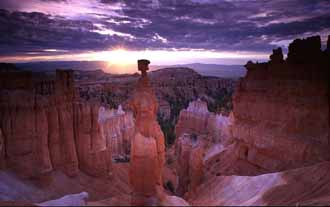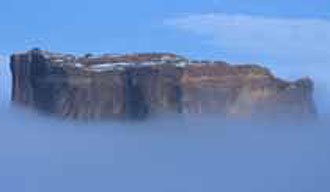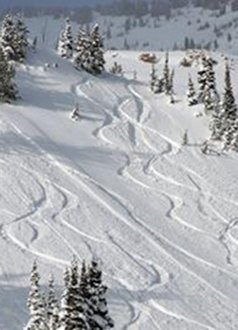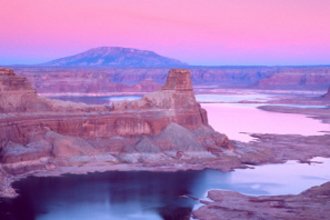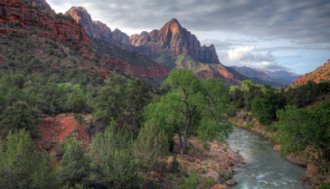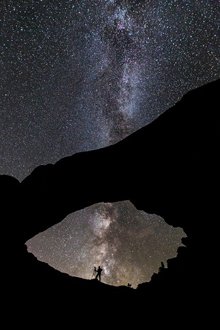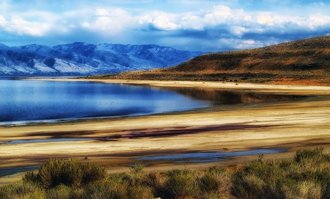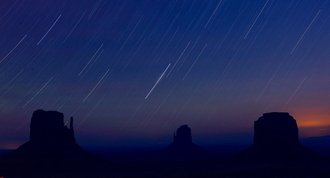That You Were Never The Same?
Deer Hunting In Utah
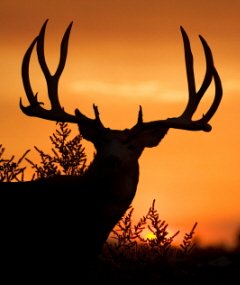
There are more mule deer in Utah than any other big game animal. And deer hunting in Utah is big business.
Why? Because trophy mule deer are one of the most alluring game species in North America.
Few experiences will get your heart pounding harder than seeing a monster muley ... sporting a massive rack ... close up in the wild. It’s happened to me every time I’ve had the privilege of seeing one. Maybe it’s because I’ve come to realize how hard it is to actually get close enough to see one.
And, yes, there still are deer like this in Utah. But a number of factors are making it harder to even see one let alone have the chance to hunt one.
One thing you should be aware of. There are no whitetail deer in Utah. An occasional whitetail may wander in from a neighboring state but such occurrences are rare.
Is Deer Hunting In Utah As Good As It Used To Be?
One thing that’s apparent to anyone who has enjoyed mule deer hunting in Utah ... or hunting for their shed antlers ... for any length of time. The deer population here has been declining. For the last 30 years to be exact.
Many factors can be blamed for the decline. But the main reason is becoming a common theme throughout the country. There’s just less land available for mule deer to thrive. And the land that’s left has deteriorated to the extent it’s now detrimental to healthy mule deer numbers.
Whenever a species like mule deer has less suitable habitat, disease and predation by other species are magnified. Favorable habitat for good deer hunting in Utah is also shrinking due to an overall climatic trend in the state. A trend toward drier conditions. Drought has existed in a lot of the state for several years.
Deer hunting in Utah is allowed in most public areas of the state except for national parks, national monuments and state parks. It’s managed by the Utah Division of Wildlife Resources (DWR) and proclamations are set yearly.
The best way to plan for a hunting trip is to check the latest Utah big game proclamation. You can do that online at the DWR site.
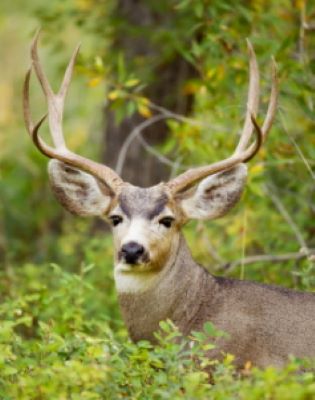
Mule deer are spread throughout the entire state. Some of the best deer hunting in Utah is:
- in the Wasatch and Uinta Mountains east of Salt Lake City .
- in all the national forest areas across the Colorado Plateau.
- in the La Sal and Abajo Mountains of southeastern Utah.
- in the Paunsagaunt Plateau area of southern Utah.
- along the Skyline Drive mountaintop road of central Utah.
- in all the national forests and throughout the state’s vast mountainous areas.
Why Are They Called Mule Deer?
Mule deer are members of the deer (or cervid family) along with moose, elk and caribou. Cervid males grow boney antlers which are shed each year.
And of course, these antlers are the cause of many a hunter’s reason for hunting. One interesting note. A buck’s antlers start growing immediately after they are shed in late winter.
The name – mule deer – is quite appropriate. They have large ears. A lot like a mule’s ears. For the unfamiliar, males are known as bucks. Females are does. Youngsters are fawns.
Bucks – especially mature ones – tend to stay away from the does and fawns during the summer’s antler growing period. During this period, their antlers are covered with smooth “velvet” which provides nourishment to the growing antlers. This velvet is shed usually in early September.
Seeing a huge buck in velvet is still one of the most captivating sights I’ve ever seen in the mountains of Utah.
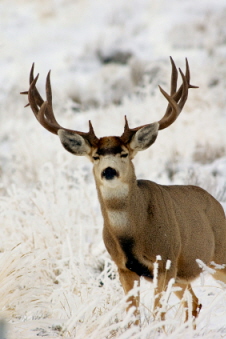
The rut is something most deer hunters know a little bit about. The rut is the breeding period for mule deer and usually peaks in mid-November in Utah. During the rut, bucks will seek out and round up several does waiting for them to come into estrus. The rut is when big bucks develop the thick neck you’ve likely seen in some photos.
Mule deer bucks become reclusive again after the rut until they shed their antlers in late winter. At this point, they’ll join herds of does and fawns and become invisible by blending in with the rest of the antlerless population.
In late spring, the does seek solitude to give birth to their for fawns. The yearlings from the previous year are aggressively driven away by the does.
They may be forced to find new home ranges sometimes many miles away. When new fawns are born the annual cycle begins again.
History Of Mule Deer In Utah
Mule deer have been common in Utah since long before the state was first settled. And deer hunting in Utah goes back just as far. Back then, they weren’t anywhere near as numerous as they are today. Until after the turn of the 20th century, the mule deer harvest was totally unrestricted.
But by 1908, something had to be done as the state’s deer herd was almost gone. Deer hunting in Utah was shut down to keep mule deer from totally disappearing in the state. Hunting was allowed to resume in 1913 with a buck-only restriction remaining in effect until 1950.
Through these years, game managers began to realize that antlerless deer (does) had to be harvested to keep deer herds healthy and in balance with their environment.
The first limited hunt of does started in 1934. Antlerless permits became common in the 50’s and early 60’s.
Deer hunting in Utah evolved into a statewide event through the years. Schools closed on the Friday before the hunt started and this continued even into recent years. No use opening the schools when no one showed up anyway.
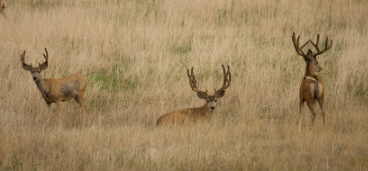
The Utah deer harvest peaked in 1961. More than 132,000 mule deer were harvested that year! As more and more hunters demanded more permits, deer numbers declined as did the available food and habitat.
As the 60’s ended and the 70’s emerged, antlerless permits were gradually reduced. And, as the 70’s went on, game managers became concerned about the declining numbers of deer. The numbers in a lot of areas were well below what the habitat could sustain.
In 1975, a buck-only hunt was initiated in Utah once again. But it wasn’t just Utah which was suffering reduced deer numbers. It was symptomatic of the entire western U.S. Buck-only hunting caused a boom and bust cycle depending on the number harvested each year.
In 1983, 82,552 bucks were harvested during the general deer hunting season. That year, 228,907 hunters took the field for the general season deer hunt. This number peaked in 1988 with nearly 250,000 total hunters enjoying deer hunting in Utah.
Nature Takes Its Toll On Utah’s Deer Herd
Nature wreaked havoc on Utah mule deer after several years of drought and a bitter winter with record snow in 1992–1993. It became apparent that Utah’s deer herd could no longer allow an unlimited hunt.
For the first time ever, buck permits were capped in 1994. Since 1994, 97,000 general season buck permits in five hunting regions have been sold each year.
This becomes a difficult process to monitor, though, as permits are sold over-the-counter. In some years, permits exceeded 97,000. By moving to a draw in 2000, sales of permits have been held real close to the 97,000 cap.
Severe drought in Utah has continued to take its toll on deer hunting in Utah. The number of permits was capped at 95,000 in 2005. And the first statewide deer management plan was approved that same year. Plans for each unit are updated every few years.
One of the biggest obstacles working against deer hunting in Utah is the maturation of the remaining plant community. Many of the most critical deer ranges are in the late stages of their life cycle. They are dominated by mature pinion-juniper, other conifers and older shrubs like sagebrush.
With pivotal winter deer ranges covered by older shrubs, there has been little regrowth of younger plants. Annual grasses such as cheatgrass are taking over a lot of traditional mule deer habitat.
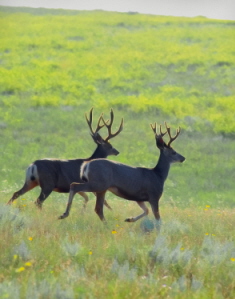
Many traditional aspen forests are being replaced in Utah by conifers which provide little forage opportunity for deer. If something isn’t done to revert crucial sagebrush terrain back to young, flourishing shrub-dominated habitat, mule deer herds will continue to suffer and deteriorate.
Trying to restore some of the crucial aspen communities to that of an early-stage forest would work wonders also. At least for the future.
Some of the other factors affecting mule deer hunting in Utah and throughout the west are both natural and man-made. The primary predators for mule deer in Utah are cougars, coyotes and, yes, even black bears.
As anyone who enjoys the outdoors has probably noticed, the number of off- highway vehicles (OHVs) has exploded. Whether those who promote these machines like to admit or not, they caused extensive damage to mule deer habitat.
From 1998 to 2006, OHV use tripled in Utah. And it’s gone up 100-fold in the last 30 years!
Uncontrolled use of OHVs not only damages mule deer range, it also causes undue stress on the deer during critical periods of their life cycle – especially in winter when energy conservation can be the difference between life and death.
While the use of OHVs on public land is a legitimate right, their uncontrolled and improper use not only damages wildlife habitat, it can kill wildlife.
For this reason, there has been an increased demand for more areas to be designated as walk-in and horseback only areas. Remote areas with fewer hunters and no OHV traffic.
Biologically, limiting areas to foot and horse travel can limit hunter pressure, reduce harvest and increase buck to doe ratios.
Still A Part Of Utah Life
Mule deer are the most important game animal in Utah. Thousands of families still plan their falls around the deer hunt. Deer hunting in Utah is strongly rooted in the social fabric. And a lot of people in the state make their living catering to people who love the fantastic outdoors.
There are few people who don’t enjoy seeing deer in the wild. A lot of time and a lot of money is spent in Utah each year watching and photographing mule deer. Areas that produce large bucks are attractive to hunters as well as people who enjoy just seeing them.
And Utah has plenty of units that produce large bucks. Even “monster” trophy bucks. Head down to the area south of the Paunsagaunt Plateau in southern Utah in late fall.
Drive some of the back roads east of Kanab with a camera and be careful your jaw doesn’t hit the steering wheel. I’ve been there and seen them.
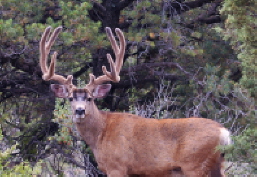
The Future Of Mule Deer In Utah
The goal of Utah game managers is to increase the state’s mule deer population to a post-season size of 350,000 by 2013. That would mean another 50,000. As precipitation appears to be returning to normal – especially this year, 2009 – it seems to be a reasonable goal.
Another one of their goals is to give residents and visitors to Utah a diverse range of high-quality hunting and viewing opportunities for mule deer throughout the state.
On Public Land. Just East of Salt Lake City.
With an Over-The-Counter Tag!
How to Plan A Utah Deer Hunt
Both the Central and the Northeastern Regions have improved dramatically in recent years. Herds in both of these regions average 16 bucks per 100 does. This allows more permits to be issued in these areas.
The Northern Region has not enjoyed the same rebound. The winter of 2007-2008 was not kind to deer in this region. The two units – the Cache and Ogden units – reduced the ratio down to 10 bucks per 100 does.
If you’re looking to get a chance at a trophy Utah buck, there are a couple ways to go. Utah has a wide assortment of professional outfitters ready and willing to help you go on the hunt of a lifetime.
If you have the resources, hiring one of these outfitters is absolutely the best way to enjoy deer hunting in Utah. They have access to land no one else has. They know where the deer are and you don’t have to worry about having thousands of other people invading your space.
And, once again, they have access to land throughout the state. Utah has some of the biggest trophy mule deer on the planet and these people will get you to where they live.
If you don’t have the resources or the desire to hire an outfitter, take a look at the big game proclamation at the Utah Division of Wildlife Resources website at http://wildlife.utah.gov/hunting/ .
It’ll give you the best overview there is about deer hunting in Utah. You can apply for one of the general permits or one of the lottery-type limited entry hunts. If you’re applying for one of these, plan a year ahead.
Licenses
Resident and non-resident permits for general hunts are available on a first-come, first-served basis from licensed dealers statewide, from DWR offices and via the internet. Permits for some of the special hunts are allotted via lotteries. Check the proclamation for those.
Hunting Seasons
All hunting seasons are set yearly. Information on big game seasons is available in January. Small game information can be obtained by late August each year.
The best source of information for deer hunting in Utah is:
The Utah Division of
Wildlife Resources
1594 W. North Temple
Salt Lake City, Utah 84116
801-538-4700
Or go to their website at: DWR Website
(Will open a new window)
Are You A Deer Hunter?
Do you love the outdoors? Have you hunted deer in Utah before?
Then you already know there are few things as enjoyable as sitting around a campfire, sharing hunting stories with friends and family!
Telling your hunting story and showing photos of your Utah deer hunt gives others the chance to experience a little bit of your hunt.
People with whom you share your story get a lot of joy out of it. And it also adds to their knowledge of the outdoors and hunting especially in Utah.
Show YOUR KNOWLEDGE to friends who share your passion!
But the difference here is that:
- your story will be placed on a separate webpage on our website.
- sharing your story is FREE.
- it’s as easy to do as typing your story.
- it will be available to you and visitors to this site any time!
Share the Best of Your Utah Deer Hunt!
And a great photo?
Then share them! They will be enjoyed by people from all over the world... for years to come.
Thank you for sharing them with all of us!
What Other Visitors Have Said
Click below to see contributions from other visitors to this page...
Utah Mule Deer Hunting Not rated yet
For over 40 years I have hunted Utah Mule deer with bow and arrow , muzzle loader, and high powered rifles.
I have watched it decline and come back …
Drew limited entry deer tag first year Not rated yet
My nephew who lives in Utah talked me into putting in for a limited entry deer tag for 2009. I agreed and did.
We put in for the Book Cliffs for the …
Utah Deer Hunt 2010 Not rated yet
What were they thinking? The Utah Wildlife Board just announced the changes for the 2010 statewide general deer hunt.
Wow! At a time when hunting …
Back to top of Deer Hunting in Utah
Back to Deer Hunting in Utah
Back to Home Page


